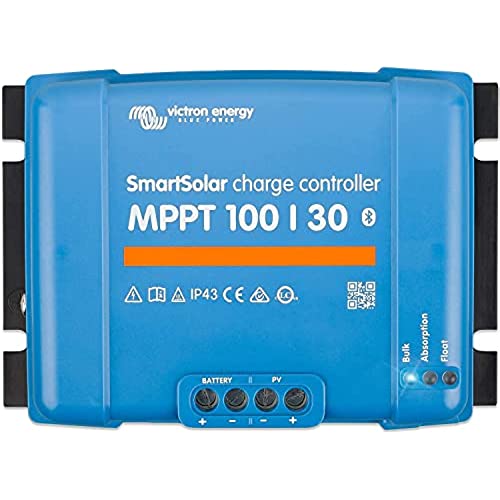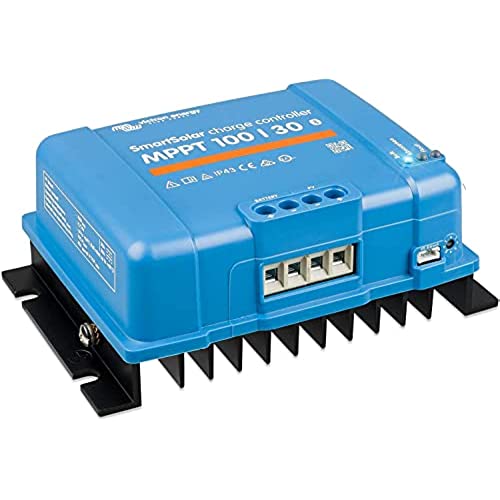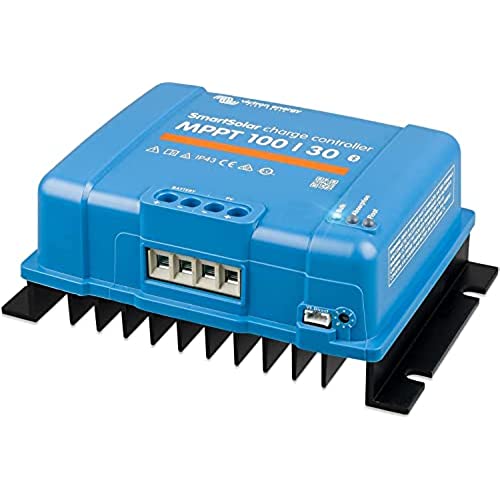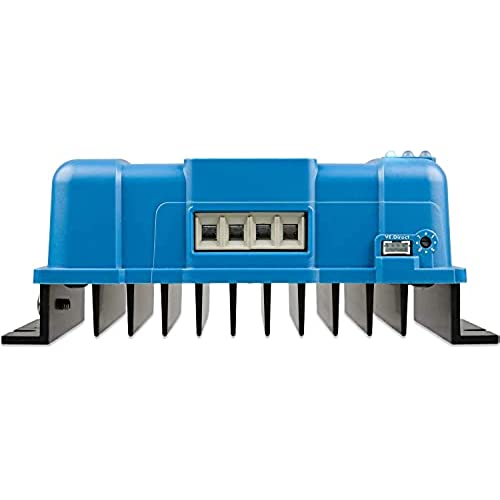









Victron Energy SmartSolar MPPT 100V 30 amp 12/24-Volt Solar Charge Controller (Bluetooth)
-

Axel_Iceland
13-06-2025Solid quality.
-

Thomas Nelson
> 3 dayWorks great! I like the app but would like a pc app better. Biggest wish is that it had a higher input voltage range. Im limited to two 72 cell panels in series for this controller. Ive got panels configured 2x2 which maxes out this controller but I of course had to use thicker wire for 20 amp from the panels.
-

rick
> 3 dayFirst ten days of use were cloudy and rainy. Power from 200 watt panel was efficiently stored in 200 ah lipo battery pack.
-

M. Dillon
> 3 dayThe 75-15 units work great and stay cool under full load. They work as advertised. That said, the 15A output limit doesnt give you much at 12V (200W) or 24V (400W) (my battery system is 24V LFP), and I made the mistake of undersizing the charge controller against my solar which runs 500W+ in full sun. Hence why I was able to make the comment about them staying cool under full load :-). So I recommend buying the SmartSolar MPPT 100-20 instead of the 75-15. The price point is still very good and those 5 extra amps can make a difference. Plus the 75-15 is limited to 24V battery systems while the 100-20 gives you the flexibility to move to a more powerful 48V battery system in the future. I also have two 100-20s. When maxed out at 20A they generally clock in at 60C and dont go much higher, so not as cool as the 75-15s. But the 100-20s are far more capable, and can handle 12/24/48V without issue. A low speed fan is all it takes to keep them in a nice comfort zone while pushing 20A to the battery. Im running 70V VOC and 80V VOC (roughly) strings with no issues into these controllers, so the input amps and losses are very low. Thus the charge controllers are limited only by the output amps. The control and programming features are great. Ive used the load output directly and the virtual load output (basically a relay control output) as well. There are a few quirks with the direct load output, it cant handle surges at all really, even short ones. The battery profile is completely customizable and output amps can be limited. I actually used one of my 75-15 charge controllers as a high-efficiency level shifter going from a 24V battery to a small 12V battery at one point using the customization to limit the current. -- It would be nice if the load output could handle more current and capacitive inflow currents on start. I have used the load output on 24V systems at around 15A without issue driving resistive loads. But just like the Victron battery-protect stuff, these FET-switched load outputs cheap-out on components and just arent very capable despite the rating. It would be nice if Victron could improve on them but I wont subtract a star since it isnt really the primary function for the charge controller and the virtual-load output works quite well. In fact, one can use the actual load output to switch certain other FET power switches, (or relays, or contactors) very quickly since they are capable of decent gate currents verses VE TX port. So there is versatility here that I like.
-

Coastside Kirk
> 3 dayIn a side-by-side comparison between this Victron unit and an HQST solar controller it’s impossible to tell any difference in battery charge current. The Bluetooth communication for setup and monitoring is easy and convenient, except for the occasional dropouts. If you really don’t need the 48 volt capability I recommend saving some money and use the other brands. I intend to run a 48 volt battery system but set up a 24 battery bank for comparison of the Victron and HQST (which is a 24 volt maximum). Each controller was connected to identical 400 watt PV arrays and battery charge current was measured by watt-hr meters. After accumulating 500 watt-hrs the arrays were swapped and test repeated. The results showed no meaningful differences in charge delivered to the battery bank. The solar climate was a mix of sun and clouds during the test. Visual snapshots of both meters during the test reinforced that both controllers were responding similarly throughout the variation in cloud cover.
-

desk jockey
> 3 dayThis MPPT controller lacks the display on something like the MidNite KIDD but, the Bluetooth connection is a better solution for most because it is easier to view than a flat panel screwed into a wall or the top of a box as part of the charge controller. The voltage and current limits are modest but, most people arent running enough solar panels for this to present a problem, or if they do they will likely want a larger more robust charge controller. Victron is much more popular in the EU so, sometimes getting accessories is a little troublesome since they dont have as good of a market penetration in the USA but, this is slowly changing. This also has a load out function which will support light loads directly from the charge controller for modest power needs.
-

MPH=CA
> 3 dayDue to the wiring nightmare to make it work between the trailer and truck.
-

Dominic Goodwin
> 3 dayGreat charge controller, but the shipping packaging was awful. Product box was destroyed and a corner of the product has a scratch. Product was only placed in a plastic mailing bag with nothing else for shipment.
-

Phil Geusz
> 3 dayI bought this for my first solar install-- 600 watts-- on a cargo trailer converted to an RV in spring of 2018. This unit was so painless and easy to configure and use that I purchased a second Victron as part of an identical twin solar setup Ive now installed in my home to power my computer stuff and TV. (Yes, this review was written on solar power.) Its ludicrously easy! My only quibbles-- not enough for me to take off a star-- center around the smartphone app. (In my case its the Apple version.) Its a good, well-organized app overall, but... First, if you have more than one controller in more than one location as I do, you have to close the app entirely between checking them or else the software seems to become confused and wont register the second controller. Also, I wish the smartphone could remember at least the last data it dowloaded, so that I could store the controller data from the trailers array and look at it later. As things are now I have to stand outside in the hot sun and study the arrays past performance, etc on the spot, as its only available while the bluetooth is actually connected. Update-- November 2018. Im still liking these very much, and have upped my home setup to 1200 watts at 24 volts nominal. The Victron controller is handling it fine.
-

Jim
Greater than one weekPerfect for our RV solar setup.







